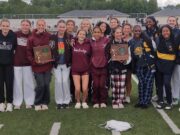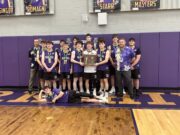As we prepare for the upcoming holiday seasons much of what we enjoy in Nearby Nature has either migrated, gone dormant, burrowed into the mud, or found a warm place to overwinter. So we thought we would get into the holiday spirit with topics relating to Thanksgiving and Christmas.
Sorry, Aunt Bee, no stuffing, cranberries, pumpkin pie, mashed potatoes, or even green bean casserole……
Thanks to the mass marketing machines of Ocean Spray Cranberries, Green Giant, and other agri-business of the food industry what we commonly think of as Thanksgiving dinner is not even close to what the first Thanksgiving dinner had to offer. What struck me as I was researching various internet sites and historical accountings of the first Thanksgiving in writing this article was the incredible amount of food that was available to the pilgrims naturally. There were no supermarkets, turkey farms, or mega fruit and vegetable farms. In addition, if it were not for the Wampanoag Indians understanding of their natural world and sharing it with the Pilgrims, they would have been a minor foot note in history.
The first Thanksgiving feast lasted three whole days, providing enough food for 53 pilgrims and 90 Indians. In November, 1621, after the Pilgrims’ first corn harvest proved successful, Governor William Bradford organized a celebratory feast and invited their newfound friends, the Wampanoag. There are only two historical accounts detailing what the fare was at the first Thanksgiving table. Edward Winslow and William Bradford talked of killing five deer, fish (cod, bass, eel, mussels, lobster), fowl and Indian corn. Through other historical accounts it is assumed that vegetables such as squash, pumpkin, beetroot, and beans were eaten. Fruits such as currants, grapes, and red plums were common and on the table as well. Cranberries didn’t come along for quite a while. Due to the diminishing supply of flour there was no bread of any kind, so no stuffing. Sugar stocks were almost non-existent and used primarily to sweeten the corn mush and boiled pumpkin. This, coupled with the fact that they had no ovens for baking, meant that there was no pumpkin or pecan pie. Potatoes weren’t part of the feast, either. Neither the sweet potato nor the white potato was yet available to the Pilgrims. The term turkey covered any type of fowl that the pilgrims hunted such as ducks, geese, pheasant, grouse and of course the wild turkey.
Did you Know!
The agriculture term Three Sisters comes from a common practice followed by Native Americans planting maize, squash and climbing beans together in a mound. The three crops benefit from each other. The maize provides a structure for the beans to climb, eliminating the need for poles. The beans provide the nitrogen to the soil that the other plants utilize, and the squash spreads along the ground, blocking the sunlight helping prevent establishment of weeds. This was one of the most important agriculture practices passed from the Indians to the Pilgrims.
The difference between the wild turkey you see in the woods today and the farm-raised Bronze breasted turkey is striking. Not only is there a greater percentage of white meat on the farm raised turkey, they are unable to fly, cannot mate naturally (must be artificially inseminated) and have a faster weight gain, getting to market weight in four to five months.
As you enjoy this Thanksgiving season full of fellowship and feasting, it is only appropriate that we stop for a second and appreciate our natural surroundings and give thanks for the glory and splendor Mother Nature has to offer. From our families to yours… Happy Thanksgiving and enjoy Nearby Nature!
Interested in more Nearby Nature?
Tracing the Trolleys (December 4, 1:00-5:00pm): Discover the artifacts of a bygone era when the towns and villages of northeast Ohio were linked by a web of electric rail lines. A trolley system connected Garrettsville, Middlefield, and Chardon to Cleveland but not each other. Each of the three rail lines left clues scattered across the landscape of Portage and Geauga that will help us understand this bygone era. Transportation will be by college van, so space is limited. Pre-registration is required (330.569.6003 or sorrickmw@hiram.edu). Sponsored by Friends of the Hiram College Field Station (fee: $7 for members, $10 for non-members)
Send your questions or comments to: nearbynature@weeklyvillager.com
Matt Sorrick is Director of The Center for Science Education at Hiram College. Joe Malmisur is an executive member of the Northeast Ohio Forestry Association and amateur naturalist.











